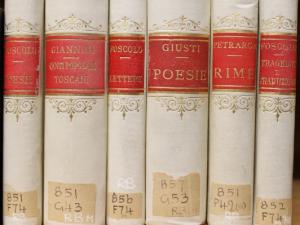Miniatures Collection
The miniatures collection, of some five hundred volumes, comprises works of 14 cm or less in height. In collectors' terms, this is a generous interpretation of the definition of a miniature, which is usually just 3 inches (7.6 cm) in height and has arisen due to shelving and conservation considerations in the Library.

The smallest item, The Lord’s prayer in seven languages, is just 5 mm in height and must be read with the aid of a magnifying lens. It is, in fact, engraved rather than printed. The smallest traditionally printed work, a 1728 Biblia (a summary of the Old and New Testaments) is comparatively large at 3.6 cm high and can be easily read with the naked eye.
Items within the collection are largely modest productions, though some are of interest for their printing or binding. Examples include J.M. Barrie’s essay on the burial of George Meredith, finely bound in red morocco by Sandorski and Sutcliffe, as well as a 19th century edition of the New Testament, with its polished birch wood covers from ‘the Abbotsford lands’ (the home of Sir Walter Scott) and its engraved views of Melrose Abbey and Abbotsford.
The collection covers a range of subject disciplines with the largest, by a considerable margin, being literature. The publication dates also span more than four hundred years; the earliest work, a 1561 edition of the meditations of St. Augustine, received with the bequest of Sir Samuel Way. Additional early publications include; the first edition of Theophrastus’ Characters in English (1616), Francis Bacon’s history of King Henry 7th (1662), the Defensio regia pro Carolo I (history of Charles I) 1650, and The secret history of the most renowned Q. Elizabeth and the E. Of Essex (1725) with an enclosed letter from Lytton Strachey.
Art reproduction in miniature has been well exploited and yet there are few examples in our own collection. The most notable is Ezra Pound’s memoir of the sculptor Gaudier-Brzeska (1957). Literature, on the other hand, is well represented in the collection, with a number of series published from the late 18th to the early 20th century. These include: Bell’s Poets in 109 volumes, the Little Blue Books, the Ten Cent Pocket Series, Contemporary Portraits from the Haldeman-Julius Company of Kansas and many individual editions of popular works designed to be easily read and transported. During the 1960s and 1970s there was a revival of experimental miniature publications and more recently there have been some fine typographical publications, including those of the Black Sparrow Press and the Ox Head Press Minnesota Miniatures. Czech poets are represented in a selection of editions from the 1960s, by various Prague publishers, received in the collection of Alfred French. Also in miniature format are a number of books about books, including Typographia, or the printers’ instructor, an ambitious attempt to deal not only with the art of printing but ‘every subject connected with the art’ (1824) and, most appropriately, Make mine a small one, a librarian’s endorsement of the reading advantages of small books.
Contemporary social and political issues are reflected in the Quotations from Chou En-Lai, a 1969 Melbourne publication with an introduction by C.P. FitzGerald. The Little Red School Book, originally published in Danish in 1969, encouraged students to question the culture of school, education and society generally, whilst The Black and White Book: a handbook of revolution, issued in 1972, had an even broader and more radical agenda. Of local South Australian interest are Helen Spence’s early 20th century pamphlet From kindergarten to the University on the education of girls and three gifts of medical works by Adelaide medical staff and graduates. Also within the collection is an 1828 edition of Cullen’s Nosology (the gift of Sir Henry Simpson Newland), a Pharmacopoeia compiled for use in the Adelaide Hospital (presented by Dr W.R. Cavenagh-Mainwaring) and a work dealing with conception, birth and physiognomy, falsely attributed to Aristotle, donated by Dr. A.W. Wall.







